The Rocky Mountain Instinct 90 Puts the 'All' in 'All Mountain'
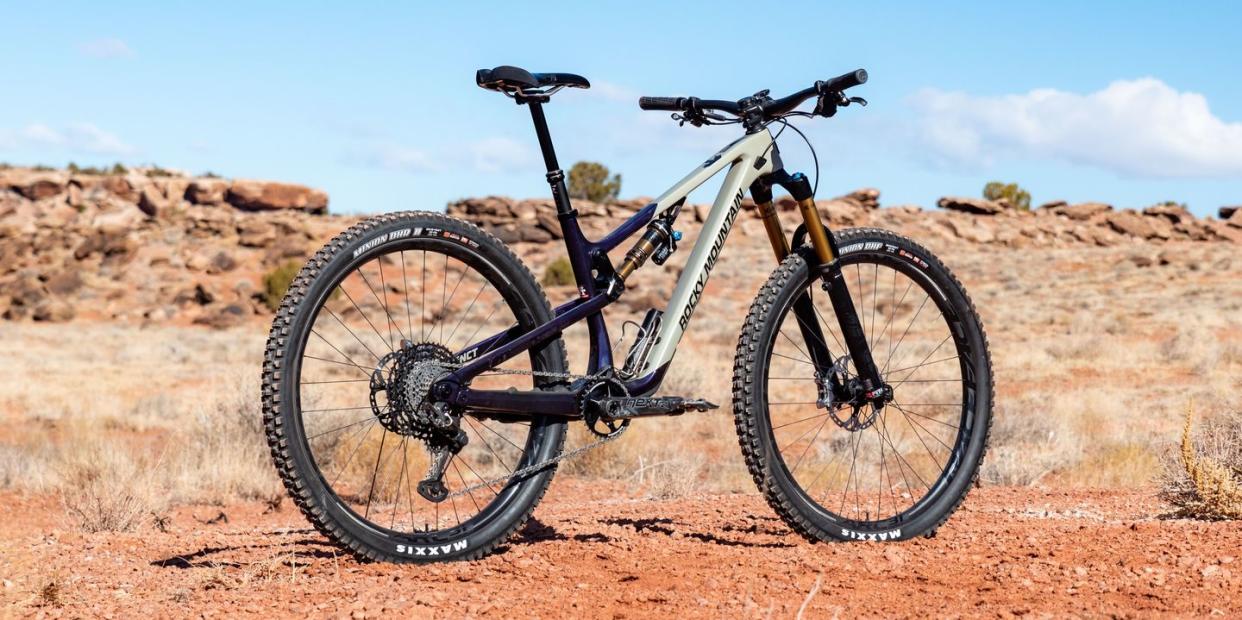
The Takeaway: a dialed and capable bike that puts the “all” in all-mountain.
140mm/150mm (rear/front) with adjustable geometry and shock rate
Eight models (two aluminum, six carbon) priced $3,129 to $10,499
2021 updates include modernized geometry and increased anti-squat
Carbon models share a frame with Rocky’s 160/170mm Altitude
Price: $9,399 (Instinct Carbon 90 tested)
Weight: 29.1 lb. (medium)
It’s new bike day at Rocky Mountain. The Canadian brand is rolling out the latest version of the Instinct—its mid-travel—140mm rear, 150mm front—suspension bike built for all-mountain and all-trail duty. The Instinct is notable not just for its clean lines and simple profile, but also for its highly adjustable suspension and geometry. My ride impressions are below, followed by a dive into the bike’s features and a breakdown of the eight models Rocky offers.
—Rocky Mountain Instinct Carbon 90 Details—
Rocky Mountain Instinct Ride Impressions
A lot of the bikes in this category are, like the Instinct, jacks of all trades, but masters of none. Even so, some stand out for their ability to navigate technical terrain (the Pivot Switchblade), or are more playful than most (Evil Offering), or push the limits on geometry (Pole Stamina). But the Instinct feels like a middle-of-the-road bike in the middle-of-the-road category. That’s not a bad thing, however. While doesn’t break any new ground or scramble category paradigms, it does everything it’s supposed to do, and does it well.
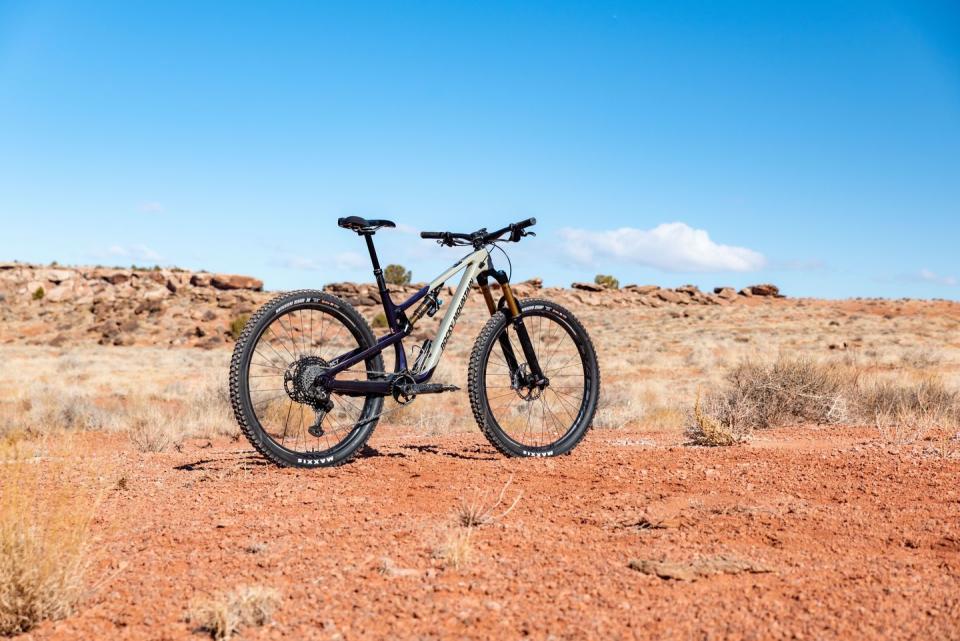
One of the good things about this centered nature is that I immediately felt comfortable on the Instinct. There’s not a learning curve or any quirks to navigate: just set sag and send it. The frame is the “right” amount of stiff (not under or over stiff); the steering is lively and neutral; it is stable but not dead-feeling; the rear suspension is smooth and consistent. I was shocked at how quickly it disappeared under me on the first ride—five minutes in and the Instinct felt as familiar as a bike I’d ridden for 100 hours.
For all-around trail riding, the Instinct is as good a bike as it gets. It can smash chunky trails well and dances admirably through tight and techy trails. It’s light enough to bring on all-day rides with epic climbs and capable enough for some light enduro smashing and bike park partying.
Some of this versatility is unlocked by taking advantage of the Instinct's suspension and geometry tuning options. While I played around with a number of settings, I spent most of my time with the bike set in “neutral” geometry, with less progressive rear suspension, and the short chainstays/wheelbase, which worked well for my riding preferences and my usual rides.
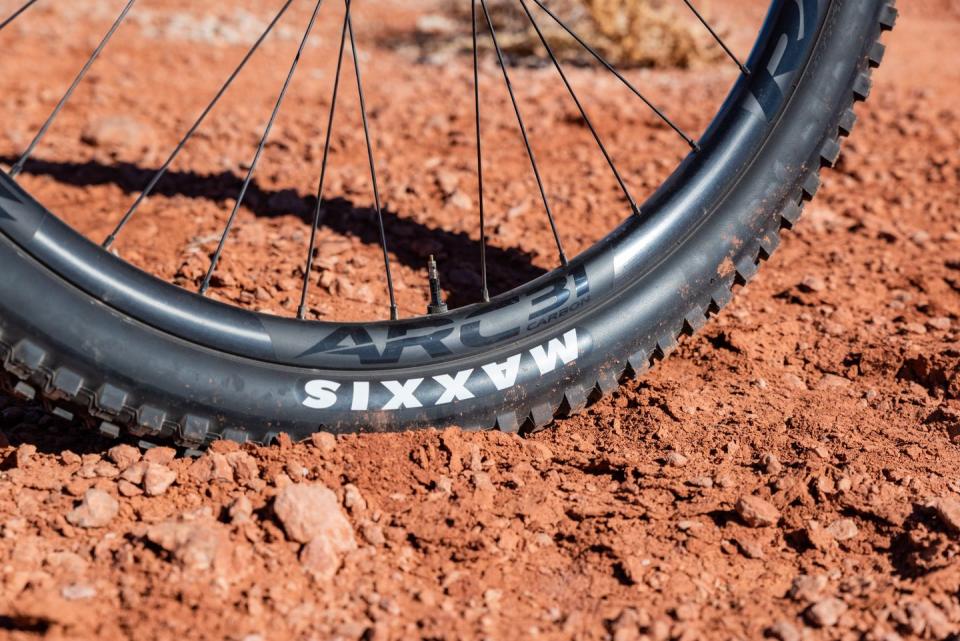
That said, the bike does noticeably change character in the other settings so if you want a bit more stability for shuttle riding, or a truer tracking front end for a high-country ride with massive climbs, you just need to spin some wrenches to get them.
The rear suspension feels tuned more for sensitivity and traction than pedaling efficiency. On smoother climbs, I flipped the shock’s switch to the middle or firm mode to get more support and crispness out of the rear end. And because I used the shock’s climb switch more often on this bike, I appreciated having a similar adjustment upfront on the Fox 36 with FIT4 damper.
While it might call for an assist from the climb switch on smoother climbs, the suspension traced the ground very well on chunky, ledgy, or traction-challenged climbs, even when pushing hard in the lowest gear. I didn’t feel any pedal kickback either. And even though, in open mode, the rear suspension settles into its travel more than some bikes on steeper climbs, the Instinct’s steep seat angle helps keep you on top of the pedals.
For another opinion, I gave this bike to Darian—a former pro downhiller, national champion, and ace mechanic—to test in Sedona, Arizona.
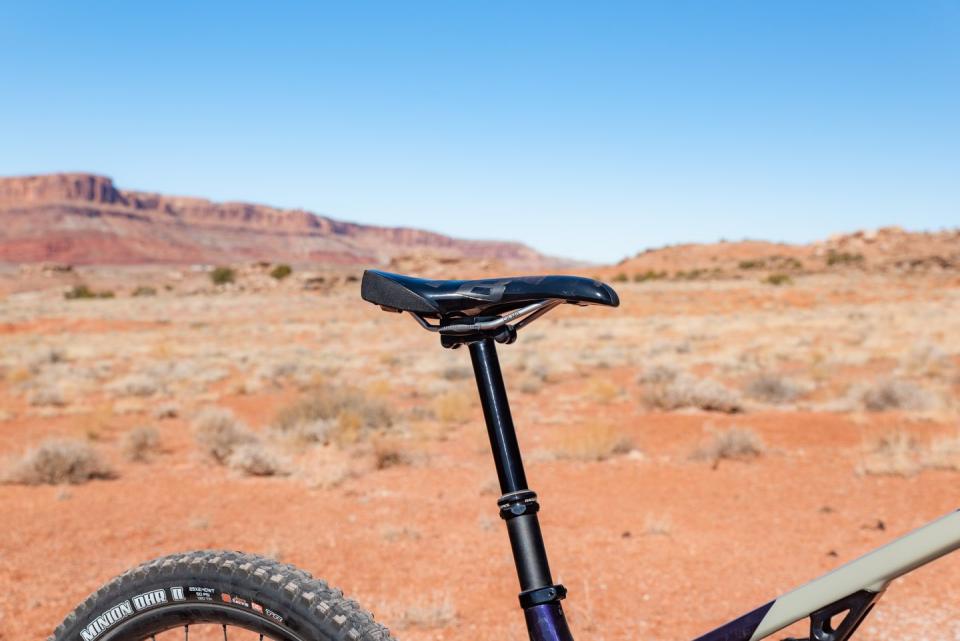
She reported starting with the Ride 9 in the slackest setting but found the front end wandered a lot and, “There were LOTS of pedal strikes. I moved to the middle setting and it helped limit pedal strikes while keeping the geometry not too steep.” Once she settled on her ideal setup, her opinion of the bike changed. “I could climb and descend to my heart’s content. I loved this bike.”
Both Darian and I loved color, which is a combination of metallic purple and flat tan which sounds a bit weird, but it looks simultaneously fun and classy. You can also get the bike in gloss turquoise with matte black.
The Carbon 90 gets a high-performance dream build, which brings the price to a pretty staggering $9,399 (prices start at $3,129 for the alloy version). Shimano’s XTR shifting is amazing, and the Race Face carbon rims are an underrated option with a snappy feel and supple ride. I was also happy that Rocky didn’t get cute with the tires and just went with the Maxxis DHF/DHR combo equipped with the more robust EXO+ casing. This isn’t a light tire combo, but it’s tough, reliable, and predictable.
—Rocky Mountain Instinct Carbon 90 Build—
Fork Fox Factory 36 Float FIT4, 150mm travel, 44mm offset
Shock Fox Factory DPX2, 210 x 52.5mm
Dropper Race Face Turbine R
Derailleur Shimano XTR
Shifter Shimano XTR
Cranks Race Face Next R, 32t ring
Brakes Shimano XTR Trail, 180mm rotors
Wheels Race Face ARC Carbon 31 rims, DT-Swiss 350 rear hub, Rock Mountain front hub
Tires Front-Maxxis Minion DHF 2.5 WT 3C MaxxTerra EXO+ TR, Rear- Maxxis Minion DHR 2.4 WT 3C MaxxTerra EXO+ TR
Handlebar Race Face Next R 780mm
Stem Rocky Mountain 35 CNC
Saddle WTB Volt Race 142
Grips Ergon GE1 Evo
Extras OneUp Components Top Guide
I was a bit surprised to see the FIT4 damper in the Fox 36 instead of the GRIP2. The GRIP2 is better in demanding terrain, but the FIT4 is lighter and helps Rocky keep this model’s weight at about 29 pounds—an impressive number for a 140/150mm bike with some solid parts. Plus the FIT 4 has a climb switch, which suits this bike’s do-it-all character.
The parts weren’t perfect though. The WTB saddle has chromoly rails, which seems a bit cheap on a bike this expensive—it should be the titanium-railed version. And though I love the modulation and power of Shimano’s XTR four-piston brakes, these suffered from the wandering bite point—which seems more pronounced in colder weather—and pad rattle: two things that seem to plague these brakes more often than not. The pad rattle I solved by swapping in aftermarket pads without cooling fins; the wandering bite point I, unfortunately, just had to deal with.
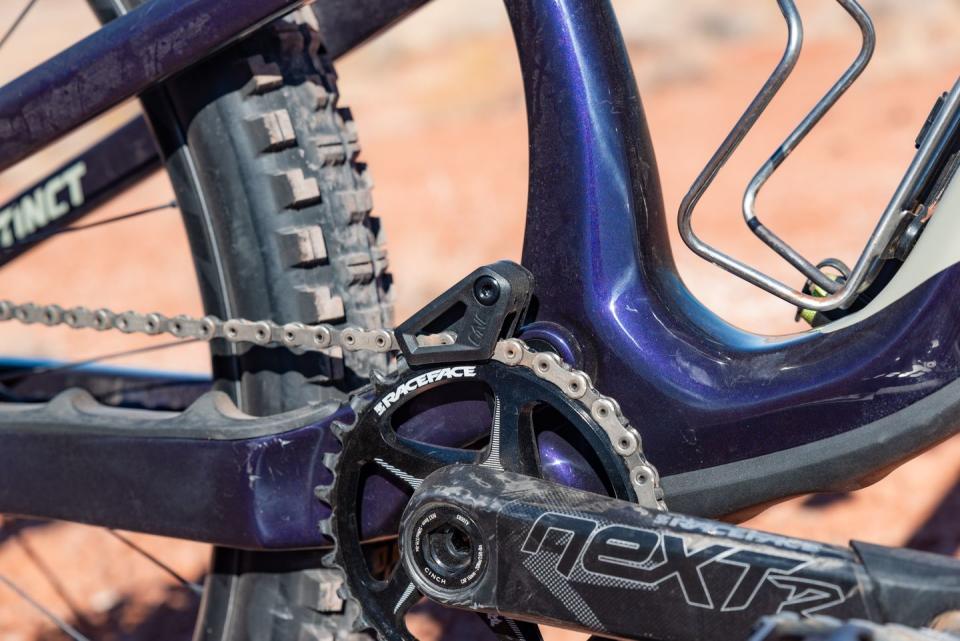
Those small issues aside, the Instinct Carbon 90 is a lightweight and versatile all-mountain bike. It may lack a hook that makes it stand apart from a crowded pack of very good bikes, but I found myself appreciating the Instinct’s capability and intuitive feel the more I rode it. Put its wheels on a trail, almost any trail, and you’ll have a ripping good time.
Rocky Mountain Instinct Models and Prices
Rocky offers the Instinct in two frame materials and eight models. Frames come in six sizes—extra small through extra-large.
The extra-small size rolls on 27.5 wheels, while the small is rider’s choice: 29 or 27.5. The medium through extra-large are 29er only.
You can find the full build kit breakdown at Rocky’s site, but there’s a quick rundown of prices, claimed weights (size medium) and spec highlights below.
Two models stand out in particular: the Carbon 70 Coil with Cane Creek coil-spring suspension front and rear, and the great build and solid value offered by the Alloy 50.
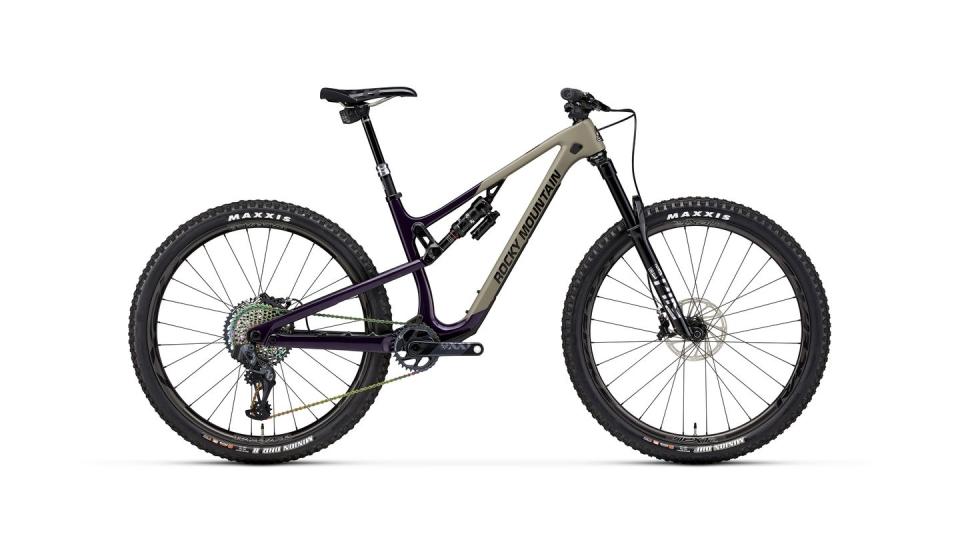
Carbon 99 $10,499
28.8 lb.
RockShox Pike Ultimate fork with Super Deluxe Ultimate shock
SRAM XX1 Eagle AXS derailleur and Eagle AXS shifter
SRAM XX1 crank
SRAM G2 Ultimate brakes
RockShox Reverb AXS dropper post
Race Face Next R carbon wheelset
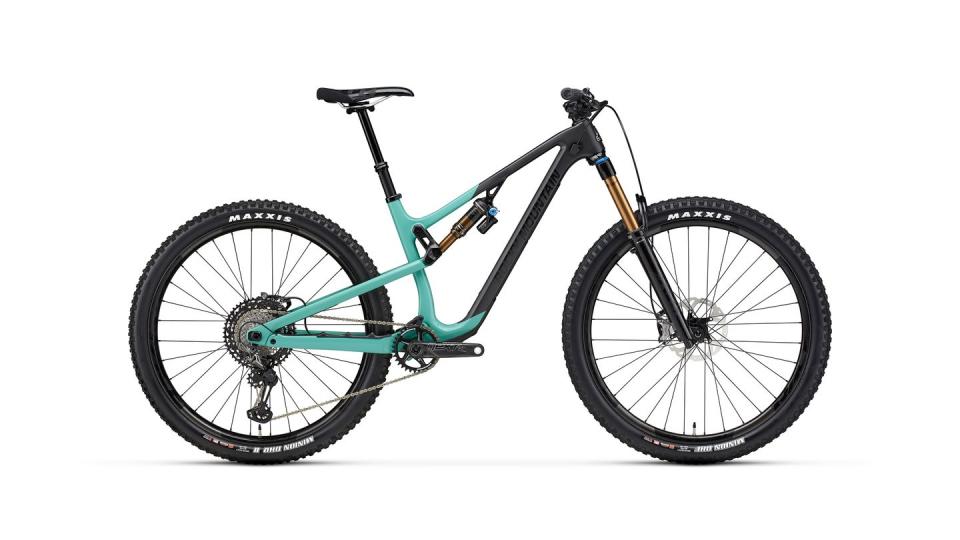
Carbon 90 $9,399
30.0 lb.
Fox Factory 36 FIT4 fork with DPX2 shock
Shimano XTR derailleur and shifter
Race Face Next R crank
Shimano XTR Trail brakes
Race Face Turbine R dropper post
Race Face ARC Carbon 31 rims with DT-Swiss 350 rear hub
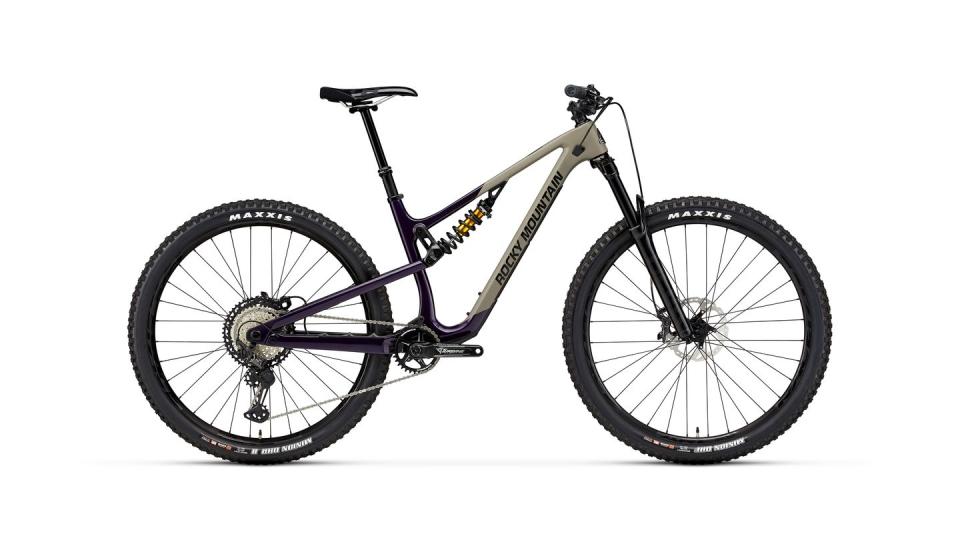
Carbon 70 Coil $7,629
32.o lb.
Cane Creek Helm Coil fork with DB Coil IL shock
Shimano XT derailleur, shifter, and crank
Shimano XT Trail brakes
Race Face Turbine R dropper post
Race Face ARC 30 rims with DT-Swiss 350 rear hub
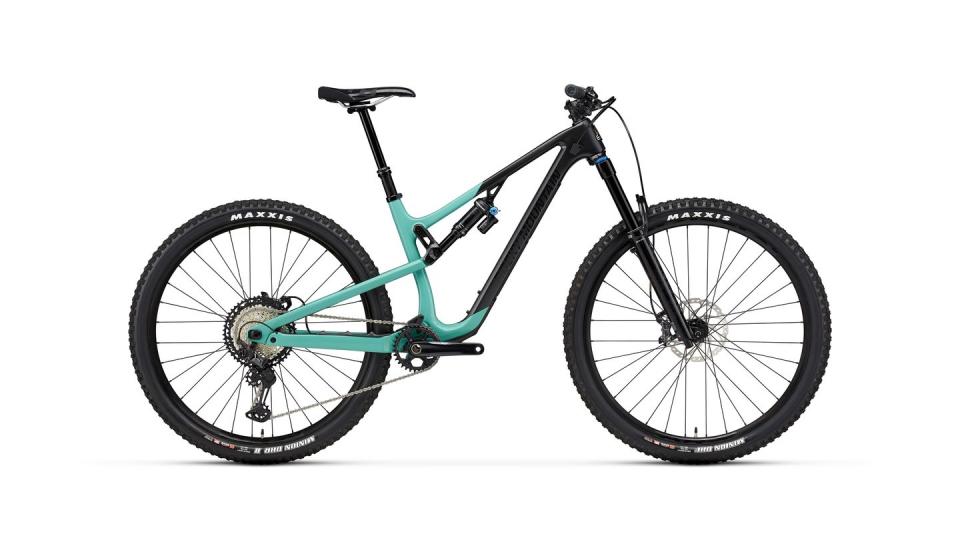
Carbon 70 $6,899
31.3 lb.
Fox Performance Elite 36 FIT4 fork with DPX2 shock
Shimano XT derailleur and SLX shifter
Race Face Aeffect crank
Shimano XT Trail brakes
Race Face Turbine R dropper post
Race Face ARC 30 rims with DT-Swiss 370 rear hub
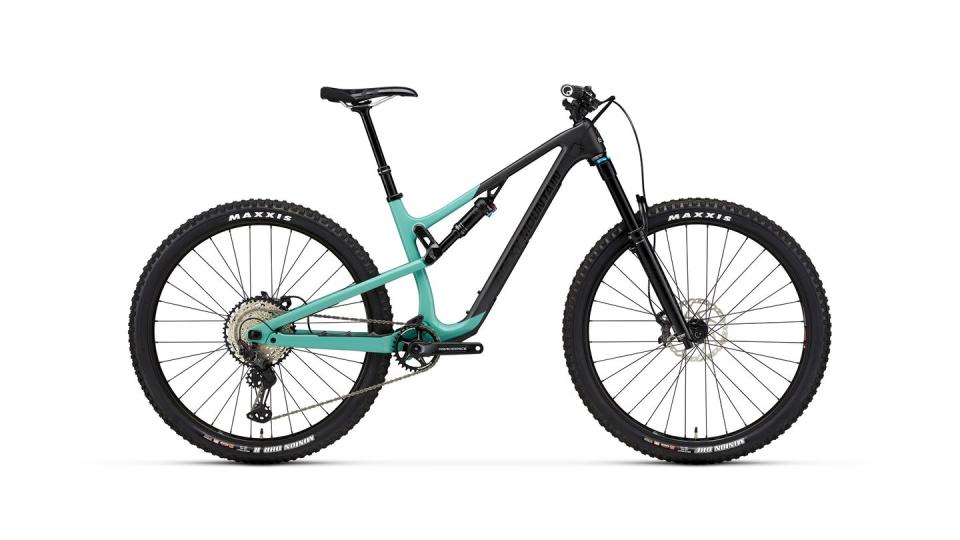
Carbon 50 $5,549
31.1 lb.
Fox Performance 36 GRIP fork with Float DPS shock
Shimano XT derailleur and SLX shifter
Shimano XT Trail brakes
Race Face Aeffect crank
Rocky Mountain Toonie dropper post
WTB ST Light i30 rims with DT-Swiss 370 rear hub
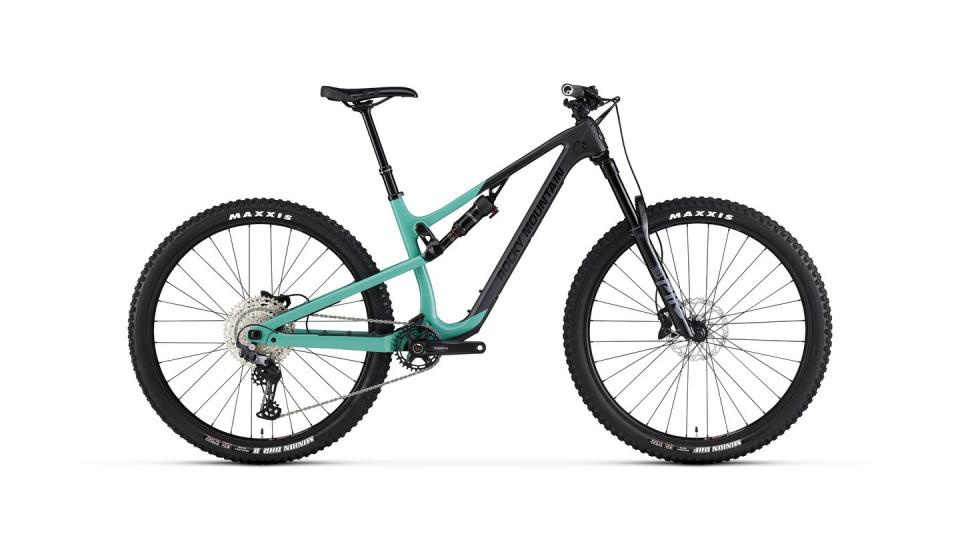
Carbon 30 $4,499
31.7 lb.
RockShox Pike Select RC fork with Deluxe Select+ shock
Shimano Deore 12-speed derailleur and shifter
Shimano Deore crank
Shimano MT4120 four-piston brakes
Rocky Mountain Toonie dropper post
WTB ST i30 rims with Shimano MT410 hubs
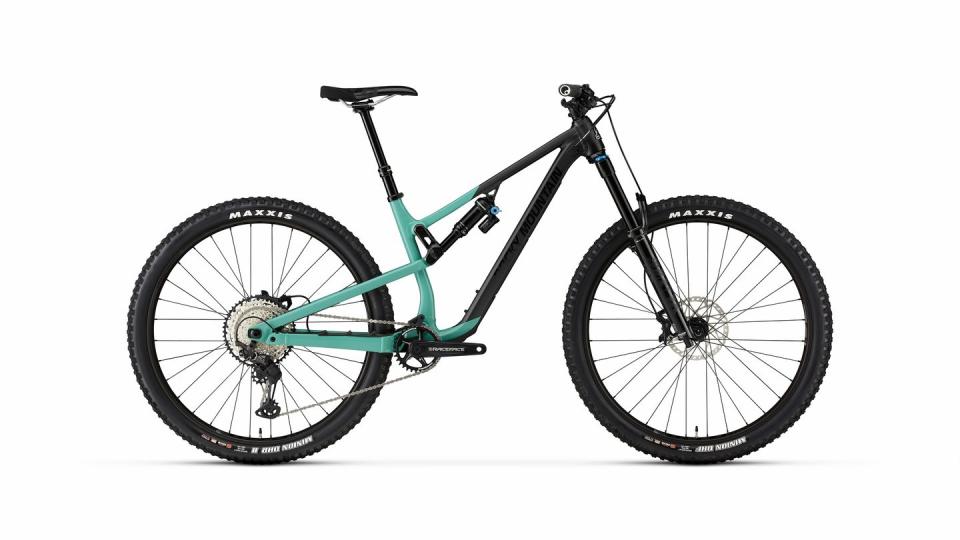
Alloy 50 $4,499
33.7 lb.
Fox Performance 36 GRIP fork with Float DPX2 shock
Shimano XT derailleur and SLX shifter
Race Face Ride crank
Shimano SLX Trail brakes
Rocky Mountain Toonie dropper post
WTB ST Light i30 rims with DT-Swiss 370 rear hub
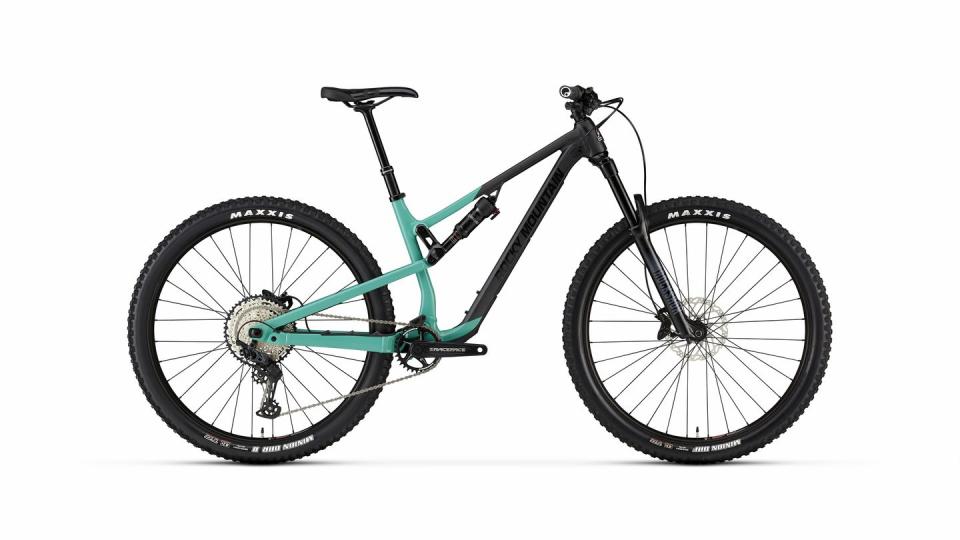
Alloy 30 $3,129
34.7 lb.
Shimano Deore 12-speed derailleur and shifter
Shimano Deore crank
Shimano MT4120 four-piston brakes
Rocky Mountain Toonie dropper post
RockShox 35 Gold RL fork with Deluxe Select+ shock
WTB ST i30 rims with Shimano MT410 hubs
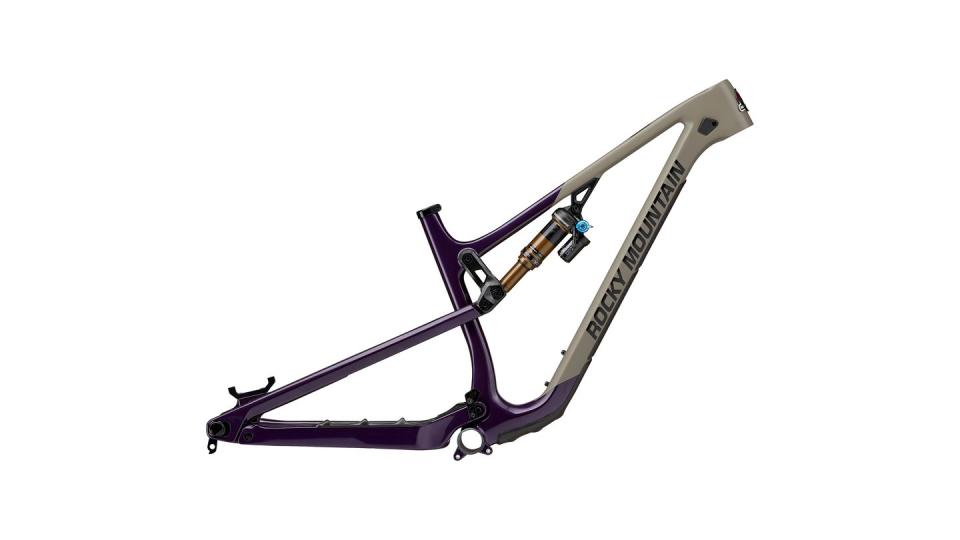
Carbon frameset $3,549
6.90 lb.
Fox Factory DPX2 shock
Rocky Mountain Instinct Geometry and Suspension Adjustments
One of the more intriguing things about the Instinct is its adjustable geometry. There are two geometry adjustment tools: Rocky’s Ride 9 system in the rear shock mount, and a chainstay flip-chip.
The latter is straightforward: chips in the chainstays provide ± 11mm of length adjustment (437 or 448mm, approximately). This change also alters wheelbase length by ± 11mm. Making the change is a bit less straightforward. Flipping the non-driveside chip requires no tools, but you also have to remove the derailleur hanger to flip the driveside chip, and also remove the brake caliper, flip the adapter, and reinstall and center the caliper.
You could do this trailside if you really wanted to, but it’s best done with the bike in the stand. The procedure is not difficult—the swap took about five minutes on my first try and a bit less time once I was familiar with the process.
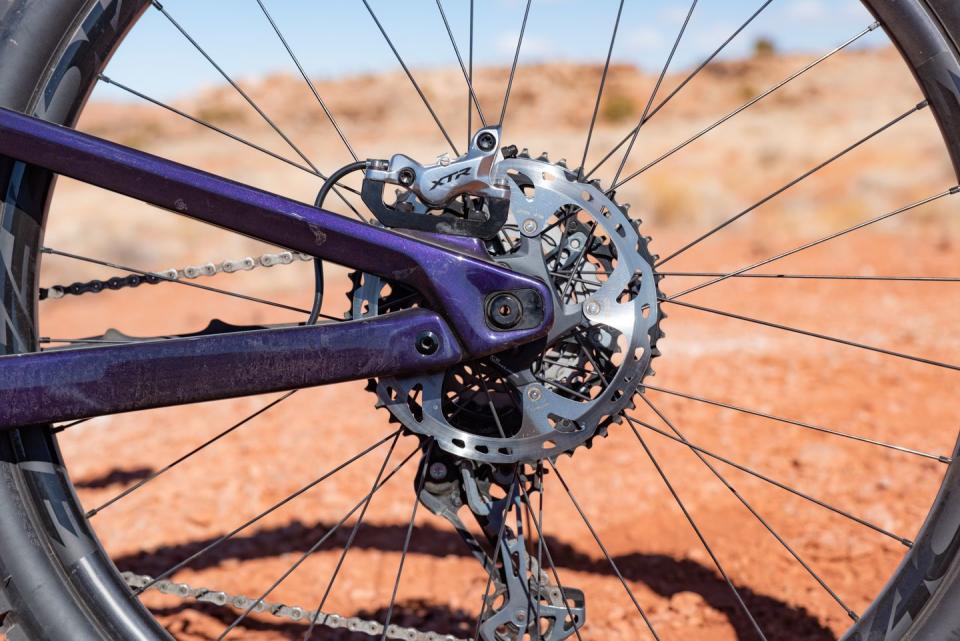
The Ride 9 system is a bit more involved if only because of all the available options. A pair of nested chips in the rear shock mount creates nine possible positions. It is not as overwhelming as it might sound. It’s actually three geometry settings and three shock rate options: 3x3=9.
Rocky calls the three geometry positions slack, neutral, steep. The total adjustment range is ± one degree of head (65.1 to 66.2 degrees) and seat angle (76.1 to 77.2 degrees adjustment, with ± 15mm of bottom bracket height change (28 to 43mm drop). All dimensions are for a size medium frame.
The three shock rate settings are less progressive, neutral, and more progressive. As you can guess, they primarily affect the shock’s end-of-travel progression. And because most Instincts come with an air shock, you have two tools for tuning shock progression: Ride 9 and shock air-volume spacers.
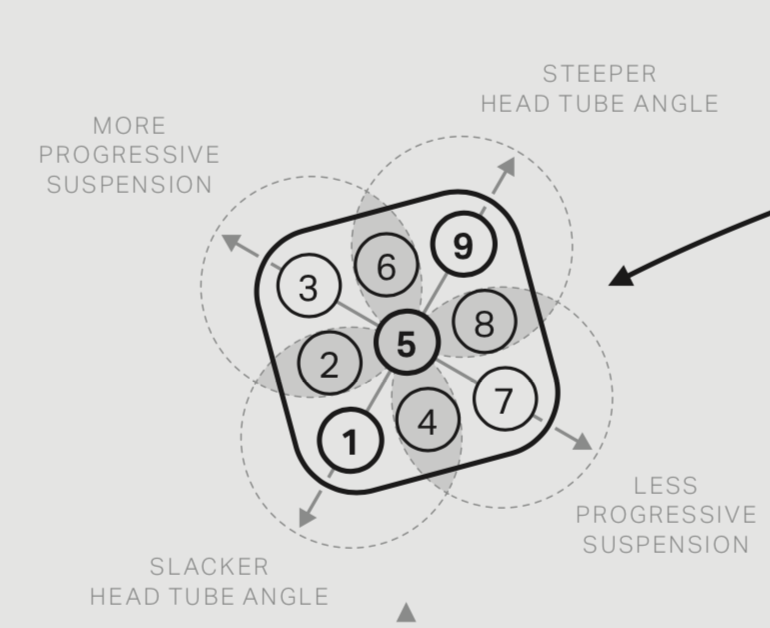
Most riders should be covered by the shock’s stock volume spacer and the Ride 9’s adjustments but, if not, swap in a different volume spacer. If you find the suspension isn’t progressive enough with Ride 9 in the more progressive setting, move up a volume spacer size; if the suspension is too progressive in the less progressive setting, drop down a volume spacer size.
Between the stay chips and Ride 9, the rider has a lot of control of the overall feel of the bike. The nice thing is, there’s no bad setting, so riders can explore the range of possible options without fear of screwing anything up. Most riders will likely find a setting they like and leave it there. But if you’re the sort who makes trips to the bike park or road trips to areas with terrain that is different from what you typically ride, the Instinct’s tuning tools make an already versatile bike even more so.
Rocky Mountain Instinct Suspension and Geometry Updates
Rocky’s familiar four-bar design with swing link carries over from the previous Instinct. The new model gets more anti-squat overall, but, even so anti-squat never exceeds 100-percent and hovers around 90-percent at sag. This means it should be a more supple and sensitive bike even when climbing hard in the lowest gear. But it also means that efficiency nerds will want to use the shock’s climbing switch more on this bike than a bike with higher levels—100-percent plus—of anti-squat.
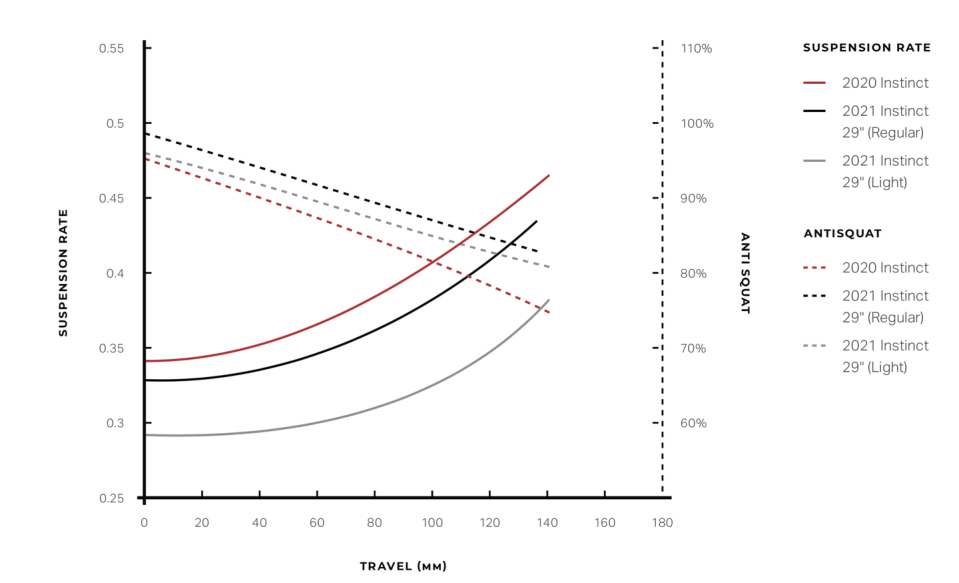
The bike’s rear travel remains 140mm, but front travel bumps up 10mm to 150mm, and geometry is longified and slackified, of course. A size medium (in the neutral setting) gets about a degree slacker (now 65.7 degrees) at the headtube and reach grows a whopping 25mm (437 to 462mm). Its top tube length grows about a centimeter, and the wheelbase stretches 30mm (now 1,209mm). Seat tube angles crank forward almost two degrees (now 76.7 degrees), while the bottom bracket sits about 6 millimeters lower. Rocky did shorten the head tube length slightly.
Rocky also cut seat tube lengths to provide more clearance for longer travel droppers. A size medium measures 420mm (down from 432), while the large and XL sizes get a 25mm reduction (now 445 and 480mm respectively).
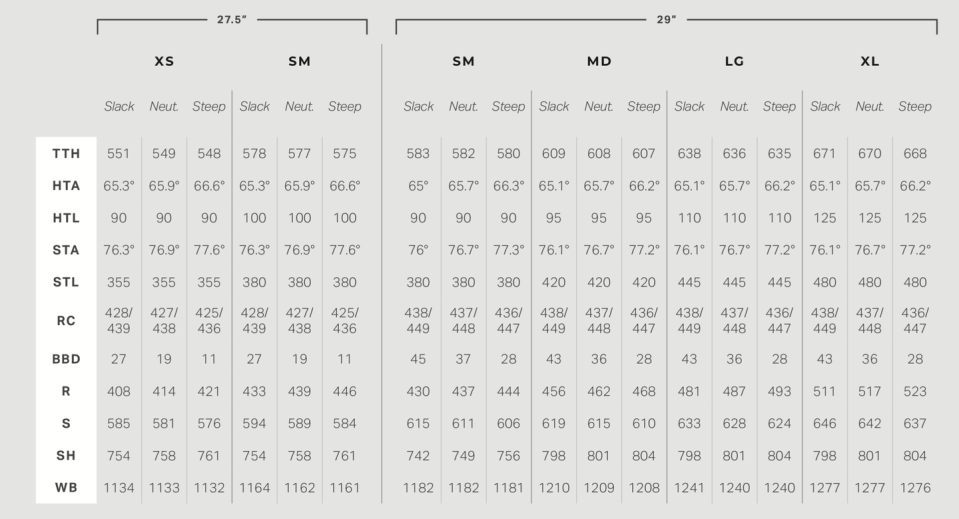
Size-Specific Suspension Tunes
Extra-small and small Instincts get a few size-specific details that differentiate those frames from the larger sizes. A kinked top tube provides more standover clearance—larger sizes have a straight top tube.
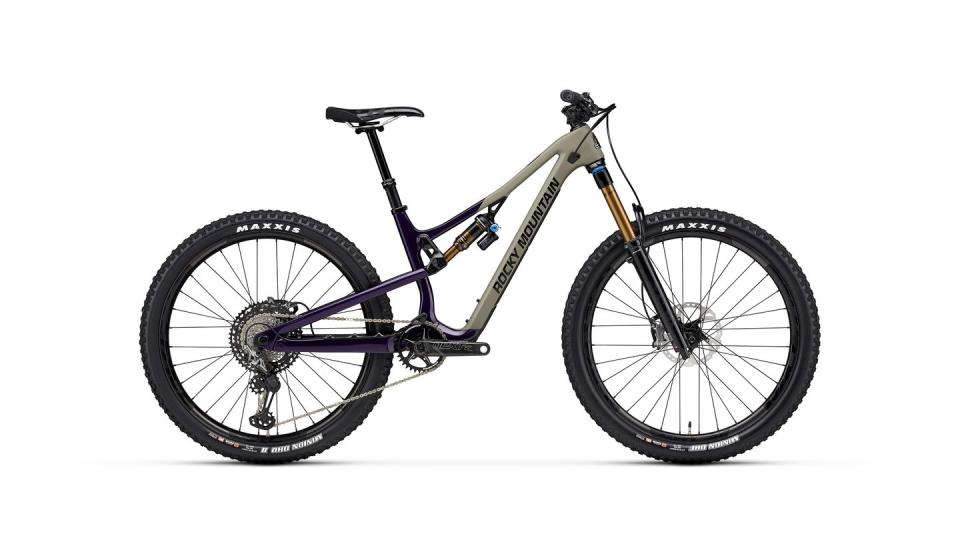
The XS and S frames also run a shorter-stroke shock but achieve the same 140mm of rear travel. This means smaller frames have more mechanical advantage on the shock, and, theoretically anyway, means more optimal suspension performance for lighter riders.
Rocky Mountain Instinct Frame Details
Most brands have signature design details that they carry through their models. So you might not be surprised that the new Instinct looks a lot like the Altitude, Rocky’s 160/170mm (rear/front) enduro bike.
But the Instinct Carbon and Altitude Carbon don’t just look alike—they share the same frame. The forward shock mount on the carbon frames is modular so Rocky can make one frame do double duty by equipping each model with a unique shock mount, and a different length and stroke shock. Those changes, plus distinct build kits, result in two different bikes with unique geometry.
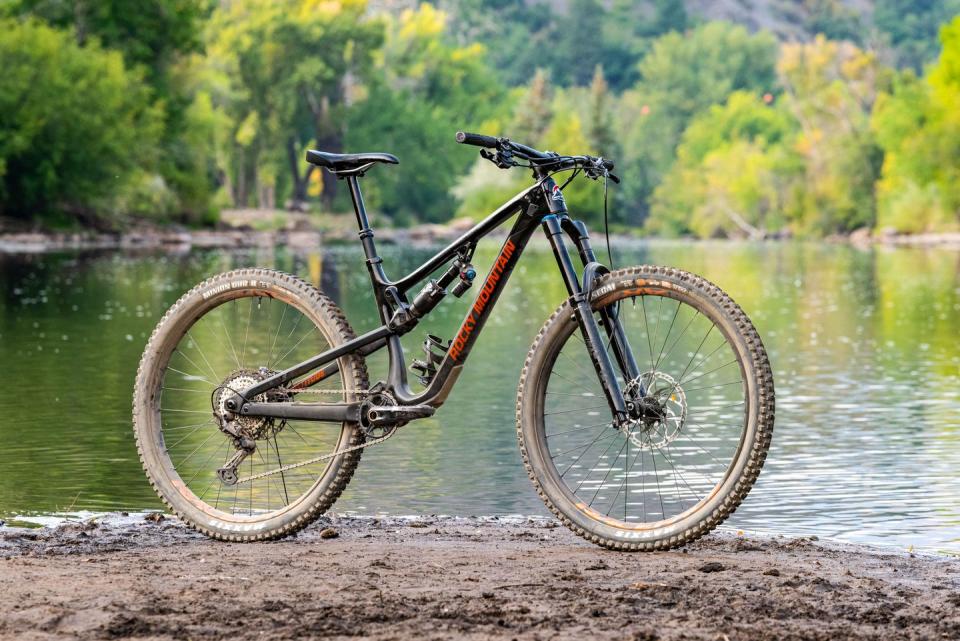
I've ridden the new Altitude Carbon and despite sharing a frame it is a noticeably different bike than the Instinct. So different that I didn't even realize they shared a frame until Rocky pointed it out.
This highlights another feature of the Instinct Carbon: you can turn it into a longer-travel Altitude. It won’t be a cheap process—you'll need the forward shock mount, a new shock, and a travel kit for the fork—but you’ll wind up with a different bike without screwing up the geometry or kinematics. You can also buy the Altitude Carbon and shorten it into an Instinct if you wanted.
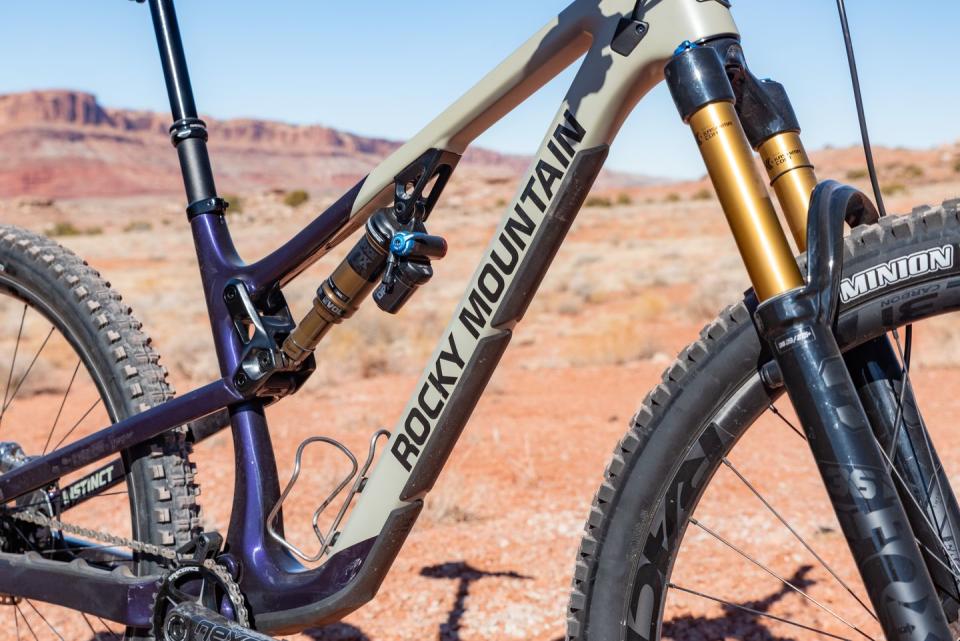
Apart from the modular, forward shock mount, the Instinct Carbon has a typical list of features. Among them: Boost 148 rear spacing, ISCG05 tabs, tunneled hose and housing routing with clamping ports (right-hand front brake friendly), press-fit 92 bottom bracket, down-tube protection, 2.6-inch tire clearance, and room for a water bottle inside the front triangle.
Instinct Alloy frames do not have the modular shock mount and are therefore dedicated to their stock travel. The Alloy frames also lack internal tunnels for the hose and housing, so routing takes a bit more effort.
You Might Also Like

